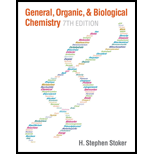
Assign an IUPAC name to each of the following compounds.
- a. CH3—(CH2)4—SH
- b. CH3—(CH2)4—OH

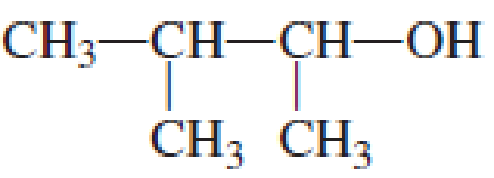
(a)
Interpretation:
IUPAC name for the given compound has to be assigned.
Concept Introduction:
IUPAC rules for naming thioalcohols that contain single thiol group:
- • Longest carbon chain has to be identified that contains thiol group also. The chain name is obtained by adding the suffix “-thiol”. If the compound contains an unsaturated bond, then the respective name has to be changed with regard to alkane.
- • The numbering has to be given so that the thiol group gets the least numbering.
- • Name and location of any other substituent present in the chain has to be identified.
- • If in a ring the thiol group is present, then that carbon is numbered 1 and the numbering then proceeds counterclockwise or clockwise in a way that substituents present if any gets the least numbering.
IUPAC rules for naming thioalcohols that contain more than one thiol group:
- • The same rules said above is followed but the prefix di-, tri-, tetra etc is added corresponding to the number of thiol groups that is present.
Answer to Problem 14.139EP
IUPAC name for the given compound is 1-pentanethiol.
Explanation of Solution
Given structure of compound is

First step is to identify the longest continuous carbon chain. In the given structure, it is found that the longest carbon chain is five carbon chain. Hence, the parent alkane is pentane.

The suffix -thiol is added to the parent alkane name. This gives the name as pentanethiol.
Next step is to number the carbon atoms so that the thiol functional group gets the least numbering. In this case, it is in first carbon atom. Therefore, the IUPAC name of the given compound is 1-pentanethiol.

IUPAC name for the given compound is assigned.
(b)
Interpretation:
IUPAC name for the given compound has to be assigned.
Concept Introduction:
IUPAC rules for naming alcohols that contain single hydroxyl group:
- • Longest carbon chain has to be identified that contains hydroxyl group also. The chain name is obtained by replacing the letter “-e” in alkane with “-ol”. If the compound contains a unsaturated bond, then the respective name has to be changed with regard to alkane.
- • The numbering has to be given so that the hydroxyl group gets the least numbering.
- • Name and location of any other substituent present in the chain has to be identified.
- • If in a ring the hydroxyl group is present, then that carbon is numbered 1 and the numbering then proceeds counterclockwise or clockwise in a way that substituents present if any gets the least numbering.
- • Hydroxyl group as a substituent in a molecule is named as hydroxy group rather than hydroxyl group.
- • If the compound contains bulky groups on same side of the double bond, then it is a cis isomer and if the bulkyl groups are present on opposite side of the double bond, then it is a trans isomer.
- • In case of cycloalkane compounds, if the substitutions are present on same side of the ring of carbon atoms, it is a cis isomer. If the substitutions are present above and below the ring, then it is a trans isomer.
IUPAC rules for naming alcohols that contain more than one hydroxyl group:
- • The same rules said above is followed but the prefix di-, tri-, tetra etc is added corresponding to the number of hydroxyl groups that is present.
Answer to Problem 14.139EP
IUPAC name for the given compound is 1-pentanol.
Explanation of Solution
Given structure of compound is

The longest continuous carbon chain with the hydroxyl group is found to be five carbon chain. Therefore, the parent alkane is pentane. As a hydroxyl group is present the name of the alcohol can be given as pentanol.

The numbering has to be given so that the hydroxyl group gets the least numbering. In this case, the hydroxyl group is present in the first carbon atom. Therefore, the IUPAC name can be given as 1-pentanol.

IUPAC name for the given compound is assigned.
(c)
Interpretation:
IUPAC name for the given compound has to be assigned.
Concept Introduction:
IUPAC rules for naming thioalcohols that contain single thiol group:
- • Longest carbon chain has to be identified that contains thiol group also. The chain name is obtained by adding the suffix “-thiol”. If the compound contains an unsaturated bond, then the respective name has to be changed with regard to alkane.
- • The numbering has to be given so that the thiol group gets the least numbering.
- • Name and location of any other substituent present in the chain has to be identified.
- • If in a ring the thiol group is present, then that carbon is numbered 1 and the numbering then proceeds counterclockwise or clockwise in a way that substituents present if any gets the least numbering.
IUPAC rules for naming thioalcohols that contain more than one thiol group:
- • The same rules said above is followed but the prefix di-, tri-, tetra etc is added corresponding to the number of thiol groups that is present.
Answer to Problem 14.139EP
IUPAC name for the given compound is 3-methyl-2-butanethiol.
Explanation of Solution
Given structure of compound is shown below,

First step is to identify the longest continuous carbon chain. In the given structure, it is found that the longest carbon chain is four carbon chain. Hence, the parent alkane is butane.
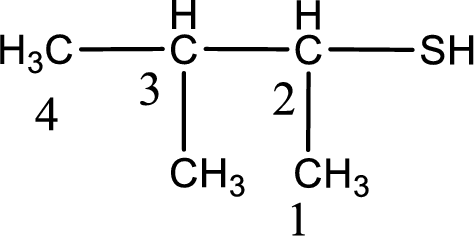
The suffix -thiol is added to the parent alkane name. This gives the name as butanethiol.
Next step is to number the carbon atoms so that the thiol functional group gets the least numbering. In this case, it is in second carbon atom. Methyl group is present as substituent in the third carbon atom. Therefore, the IUPAC name of the given compound is 3-methyl-2-butanethiol.
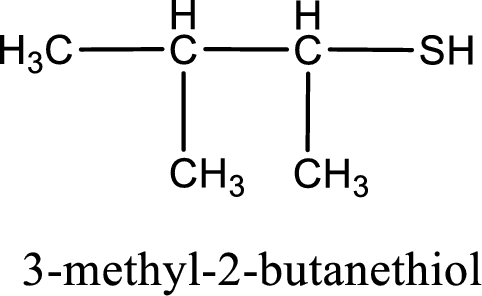
IUPAC name for the given compound is assigned.
(d)
Interpretation:
IUPAC name for the given compound has to be assigned.
Concept Introduction:
IUPAC rules for naming alcohols that contain single hydroxyl group:
- • Longest carbon chain has to be identified that contains hydroxyl group also. The chain name is obtained by replacing the letter “-e” in alkane with “-ol”. If the compound contains a unsaturated bond, then the respective name has to be changed with regard to alkane.
- • The numbering has to be given so that the hydroxyl group gets the least numbering.
- • Name and location of any other substituent present in the chain has to be identified.
- • If in a ring the hydroxyl group is present, then that carbon is numbered 1 and the numbering then proceeds counterclockwise or clockwise in a way that substituents present if any gets the least numbering.
- • Hydroxyl group as a substituent in a molecule is named as hydroxy group rather than hydroxyl group.
- • If the compound contains bulky groups on same side of the double bond, then it is a cis isomer and if the bulkyl groups are present on opposite side of the double bond, then it is a trans isomer.
- • In case of cycloalkane compounds, if the substitutions are present on same side of the ring of carbon atoms, it is a cis isomer. If the substitutions are present above and below the ring, then it is a trans isomer.
IUPAC rules for naming alcohols that contain more than one hydroxyl group:
- • The same rules said above is followed but the prefix di-, tri-, tetra etc is added corresponding to the number of hydroxyl groups that is present.
Answer to Problem 14.139EP
IUPAC name for the given compound is 3-methyl-2-butanol.
Explanation of Solution
Given structure of compound is shown below,
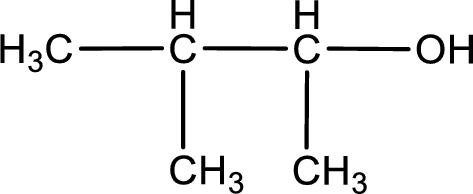
First step is to identify the longest continuous carbon chain. In the given structure, it is found that the longest carbon chain is four carbon chain. Hence, the parent alkane is butane.
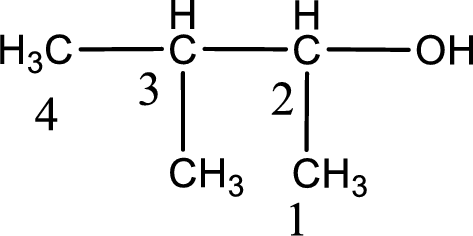
The suffix -ol is added to the parent alkane name by replacing the suffix “–e”. This gives the name as butanol.
Next step is to number the carbon atoms so that the hydroxyl functional group gets the least numbering. In this case, it is in second carbon atom. Methyl group is present as substituent in the third carbon atom. Therefore, the IUPAC name of the given compound is 3-methyl-2-butanol.
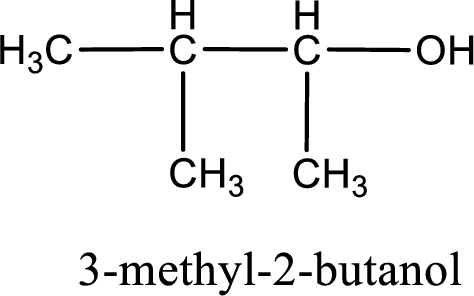
IUPAC name for the given compound is assigned.
Want to see more full solutions like this?
Chapter 14 Solutions
GENERAL,ORGANIC,+BIO.CHEM.-MINDTAP
- The decimolar calomel electrode has a potential of 0.3335 V at 25°C compared to the standard hydrogen electrode. If the standard reduction potential of Hg22+ is 0.7973 V and the solubility product of Hg2Cl2 is 1.2x 10-18, find the activity of the chlorine ion at this electrode.Data: R = 8.314 J K-1 mol-1, F = 96485 C mol-1, T = 298.15 K.arrow_forward2. Add the following group of numbers using the correct number of significant figures for the answer. Show work to earn full credit such as rounding off the answer to the correct number of significant figures. Replace the question marks with the calculated answers or write the calculated answers near the question marks. 10916.345 37.40832 5.4043 3.94 + 0.0426 ? (7 significant figures)arrow_forwardThe emf at 25°C of the cell: Pt l H2(g) l dis X:KCl (sat) l Hg2Cl2(s) l Hg l Pt was 612 mV. When solution X was replaced by normal phosphate buffer solution with a pH of 6.86, the emf was 741 mV. Calculate the pH of solution X.arrow_forward
- Indicate how to calculate the potential E of the reaction Hg2Cl2(s) + 2e ⇄ 2Hg + 2Cl- as a function of the concentration of Cl- ions. Data: the solubility product of Hg2Cl2.arrow_forwardHow can Beer’s Law be used to determine the concentration in a selected food sample. Provide an in-depth discussion and examples of this.arrow_forwardb) H3C- H3C Me CH 3 I HN Me H+arrow_forward
- Using Luther's rule, determine the reference potentials of the electrodes corresponding to the low stability systems Co³+/Co and Cr²+/Cr from the data in the table. Electrodo ΕΝ Co²+/Co Co3+/Co²+ -0,28 +1,808 Cr³+ / Cr -0,508 Cr3+ / Cr²+ -0,41arrow_forwardThe molecule PYRIDINE, 6tt electrons and is there pore aromuntre and is Assigned the Following structure contenus Since aromatk moleculey undergo electrophilic allomatic substitution, Pyridine should undergo The Following reaction + HNO3 12504 a. write all of the possible Mononitration Products that could Result From this roaction Based upon the reaction the reaction mechanism determine which of these producty would be the major Product of the hegetionarrow_forwardUsing Benzene as starting materia Show how each of the Following molecules could Ve synthesked 9. CHI d. 10450 b 0 -50311 ८ City -5034 1-0-650 e NO2arrow_forward
- BA HBr of the fol 1)=MgCI 2) H₂O major NaOEt Ts Cl Py (pyridine) 1) 03 2) Me2S 1arrow_forward4. Provide a clear arrow-pushing mechanism for the following reactions. Do not skip proton transfers, do not combine steps, and make sure your arrows are clear enough to be interpreted without ambiguity. a) NHBoc ⚫OBn HO. H3C CO2CH3 -OBn H3C H3C. H3C. NHBOC CI CO2CH3arrow_forwardDraw structures of the following compounds and identify their role: mCPBA (MCPBA) DMS Py 9-BBN LAH Sia₂BH TsCI PCC t-BuOK LDA MeLi n-BuLi DMSO DMF Sodium Borohydride Lithium DiisopropylAmide 2arrow_forward
- Chemistry: Matter and ChangeChemistryISBN:9780078746376Author:Dinah Zike, Laurel Dingrando, Nicholas Hainen, Cheryl WistromPublisher:Glencoe/McGraw-Hill School Pub Co
 Organic And Biological ChemistryChemistryISBN:9781305081079Author:STOKER, H. Stephen (howard Stephen)Publisher:Cengage Learning,
Organic And Biological ChemistryChemistryISBN:9781305081079Author:STOKER, H. Stephen (howard Stephen)Publisher:Cengage Learning, General, Organic, and Biological ChemistryChemistryISBN:9781285853918Author:H. Stephen StokerPublisher:Cengage Learning
General, Organic, and Biological ChemistryChemistryISBN:9781285853918Author:H. Stephen StokerPublisher:Cengage Learning  Chemistry for Today: General, Organic, and Bioche...ChemistryISBN:9781305960060Author:Spencer L. Seager, Michael R. Slabaugh, Maren S. HansenPublisher:Cengage Learning
Chemistry for Today: General, Organic, and Bioche...ChemistryISBN:9781305960060Author:Spencer L. Seager, Michael R. Slabaugh, Maren S. HansenPublisher:Cengage Learning



